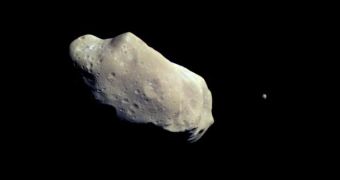Astronomers in Italy have determined that our society could be at risk of getting seriously damaged by a potential impact between our planet and an asteroid. Such a collision could take place in approximately 160 years, between 2169 and 2199, and the main suspect is an asteroid known as 1999 RQ36. It posed no danger to Earth when it was first discovered, but a new analysis of its trajectory shows that it now has a 1 in 1400 chance of hitting the planet, as opposed to the Apophis asteroid, which has a 1 in 45,000 chance of impact in 2036.
The team, based at the University of Pisa and led by Andrea Milani, says that 1999 RQ36 is twice as large as Apophis, measuring about 560 meters in diameter. A potential impact would have severe repercussions on human cities located on the shore lines, as a direct contact with the ocean would generate massive tsunamis, which could swallow cities like Tokyo and New York. Unfortunately, very few researchers use a time frame larger than 100 years when conducting their surveys of various celestial bodies, which means that other meteorites, asteroids, or comets could in the future affect our planet without us even knowing about it.
Milani says that while the potential hit could take place in more than 1.5 centuries, the time window for ensuring such a collision doesn't happen is fairly limited, and only stretches between 2060 and 2080. By that time, scientists should have already devised a means by which to nudge these chunks of rock from the orbit. Before the final impact, meteorites and other bodies travel very close to the planet they are attracted to, in a series of what astronomers have termed “near misses.”
In the aforementioned time frame, the deviation that will have to be implemented in the asteroid's orbit would measure one kilometer in length. More precisely, that's the distance on which the body has to be pushed, in order to avoid it hitting the Earth. But, after 2080, this distance will drastically increase, and could become as long as tens of kilometers.
This level of prediction is currently among the best available, but astronomers worldwide have confidence that future developments in mathematics and physics, along with better telescopes, could one day provide the conditions for them to better assess the threat level of asteroids, comets, or meteorites.

 14 DAY TRIAL //
14 DAY TRIAL //